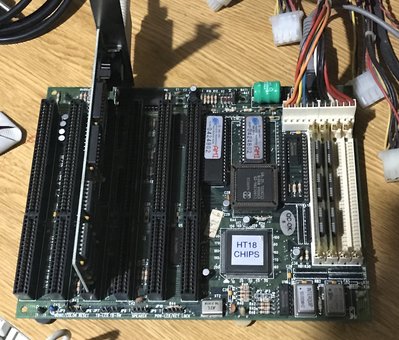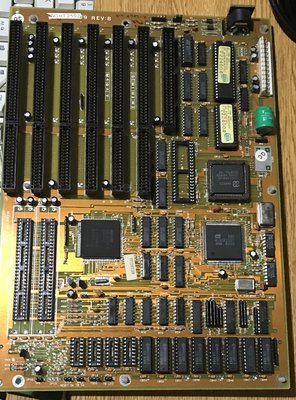I wonder what's under that HT18 chip sticker. That board looks like a PC Chips (or other re-brand) M216, so it's probably not a Headland HT18 under there (which is normally a 386SX chipset, but might have been used in some actual 286 boards, and supposedly has hardware EMS support, even).
There were more examples on ebay last year that have since expired from the completed listings archive, but these two look like they have both the same layout and trace routing:
https://www.ebay.com/itm/286-20MHz-Harris-512 … T-/223928413017?
https://www.ebay.com/itm/PC-Chips-M216-286-mo … r-/333348862200?
The bios archive here lists the M216 as using a "PC Chips Chip 3" but that's not very useful:
http://chukaev.ru54.com/bios_cs_en.htm
Those two ebay boards have different parts numbers on the stickers, too:
14L50F2056 (for 'American Chip 3')
6L70F2060 (for 'PC Chips Chip 2')
So the actual chipset may vary in revision if those numbers aren't made up. And, in spite of all the rebranding nonsense on PC Chips ICs and stickers, they often have consistent parts numbers at least, like on that M209 you have above with the Citygate D60 chipset: that got rebranded to several other things (PC Chips, Hedaka, etc), but tends to have the 4L50F2052 number consistent at least. (aside from stickers that have a brand/logo without the number, but the number is usually still there under the sticker)
The PCChips M219 used a Toshiba chipset, but prior to that it seems like they used Citygate designs quite heavily, and given the similar configuration of the parts number (looks like similar naming nomenclature used) the M216 could have continued that trend.
That BIOS page lists the Citygate D90 being used in the TD60 motherboard, and D100 and 110 as 386SX and 386 chipsets, so there could be CG D70, 80, and 90 all being 286 related. D60 EMS drivers might even be compatible (assuming the BIOS has EMS set-up options).
The D60 lacks integrated DMA, so relies on discrete DMA chips or (like in the M209) a companion ASIC with DMA built-in. (with the M209 it uses a Chips and Technologies integrated DMA and realtime clock chip, though the above example has a Siemens manufactured example)
Those M216 (or M216 looking) boards seem to have a discrete RTC/CMOS chip, so whatever chipset is uses has the more common configuration with integrated DMA and external RTC/CMOS chip.
I haven't seen any tests to compare D60 boards to M216s (or the later M219, though that's known for being pretty slow) and most if not all seem to have fixed wait states (should be 1 wait state, no 0 wait state option) so tend to be slower in that respect, but I have the impression the M219 is worse somehow. (when the D60 was new or at least current, 1 wait state on 20 MHz 286 boards also shouldn't have been unreasonable given RAM faster than 80 ns would be quite expensive, and they work fine at 20 MHz with 80 ns or even marginally so with 100 ns CMOS DRAM: I tried my M205 with 100 ns stuff briefly, but didn't try beyond POST and BIOS set-up; it threw errors with parity enabled, but I forget if I tried that with the known-good 80 ns parity chips or not)
Oh, and while there's already D60 drivers archived (I think vogons hosts the Hedaka D60 motherboard flavor of them), there's what appears to be new old stock M209 motherboard manuals and utility disks available on ebay right now at $7 shipped.
https://www.ebay.com/itm/PC-Chips-286-Utility … al/271724994296?
I picked up one of those late last year and the utility disk works fine with both my (unbranded/unmarked) M205 and a Hedaka branded D60 motherboard I have.
The manual is more useful for actual M209 boards (so relevant to that one shown above in the thread), but the utility disk doesn't seem to have anything M209 specific in it. It's just D60 based EMS drivers and RAMdisk + disk cache configuration type stuff.
Good news is the EMS implementation seems to be industry standard compatible. I haven't tried with Wing Commander 2, but the floppy disk version of X-Wing works fine and also recognizes it as EMS version 4.0.
I also didn't notice significant speed reduction with DOS loaded high, but it crashed with the board at 25 MHz (A20 errors). Happens with all the 286s I've tried in that board, but not with XMS disabled. You need a good, clean DOS + driver configuration in base memory for that to work out well, though.
(X-Wing needs 550 kB base memory free for digitized sound, though can still make use of most/all of 896 kB EMS with just Adlib sound, and imuse MIDI music doesn't play with 384 MB of EMS, but does with some of the 896 kB chunk dedicated to shadow RAM, so the music needs somewhere in between and the install program doesn't tell you)
I haven't tried using QRAM or a similar utility to free up base memory without using himem.sys and extended memory, but these D60 boards also seem to disable UMA access with EMS enabled (or at least DOS 5.0 and 6.21 both report 0 bytes present in the UMA), so it'd need to be something capable of using EMS pages.
As far as I know, there aren't any 286 DOS memory limulators or extenders that make use of the Loadall instruction to access 'bigrealmode' for direct access of the full 24-bit address range in real-mode, and I don't think himem.sys uses it (just 286 or 386 protected mode, and A20 handler weirdness to do 286 mode switching/resets). EMM286 might use that sort of hacking, but has to emulate EMS bank switching via tons of copying. It seems like LOADALL could at least be used to simulate 64kB single-bank page-frame bank switching operation in either the UMA or HMA, but I'm not sure if anything does that and I think most useful EMS-enabled software needs more advanced EMS support with 4-bank pages. (some things and a very few games use the Loadall workaround natively, but that's not much help here)
The BIOS also hangs sometimes when XMS is enabled, so it's not just a DOS or X-wing related stability issue, but something A20 handler related and/or 286-MMU stability related and/or RAM speed related: DOS loads high in protected mode, I think, so both the 286's protected mode MMU functions and the different memory access timing (1-clock tick penalty) in protected mode may impact things. (all using 60 ns Siemens 256kx4-bit CMOS FPM DRAM chips)
Note: the 384 kB of the first 1 MB of RAM (normally mapped to the UMA) is all mapped as EMS memory or shadow RAM, and anything above that can be configured as EMS or XMS in 512kB banks. (I think QRAM has some EMS support at least, and the EMS standard itself works with the page frame
I've also been using a Vibra 16S and the drivers needed to configure the I/O takes up a fair chunk of base memory (and can only move itself into XMS memory, not EMS), but other cards might be less bloated and driverless ones would be ideal.

